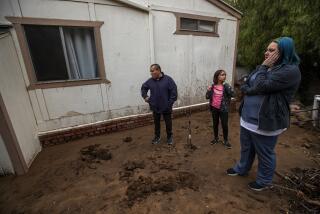Retrofitting pre-1979 homes can prevent much costlier quake damage

Over the last few years, much of the focus on earthquake safety has been on concrete buildings and wooden apartments with weak first stories, which can collapse in a major earthquake.
But single-family homes also pose risks. And there are steps homeowners can take to make their dwelling more structurally secure.
What’s the most significant risk to single-family homes?
A big problem involves homes built before 1979 with a handful of steps above the ground, where in between the floor of the house and the concrete slab foundation is a crawl space a few feet tall.
The heavy house rests atop a flimsy wood-frame perimeter that is not bolted to the concrete foundation.
So when an earthquake hits and the concrete foundation moves, the wooden part of the house snaps off — possibly falling into the backyard or through the neighbor’s fence.
“In an earthquake, what happens is that the house can either topple or slide off of the foundation,” said Janiele Maffei, a structural engineer and executive director of the California Residential Mitigation Program. “Essentially, it’s like you’re trying to pull the rug out from underneath the house.”
What can be done to make them more secure?
The solution is generally simple: add metal rods to attach the wooden house to the concrete foundation, and plywood “to add stiffness and strength to keep the house on its foundation,” she said.
These types of homes have been damaged in earthquakes as early as the 1906 San Francisco quake, as well as in the 1933 Long Beach, 1971 Sylmar, 1989 Loma Prieta and 1994 Northridge quakes, and last year’s Napa earthquake.
“It’s so distressing to drive around Napa and see these beautiful older homes that have slid off their foundation, and repairs can be in the tens of thousands to hundreds of thousands” of dollars, Maffei said. In the worst case, a house shoved off its foundation could also sever gas lines, fueling a fire.
To reattach an intact house to its foundation, an owner might have to pay to lift the entire structure several feet and pour a new concrete foundation, then lower the house down at a cost as high as $400,000.
By contrast, the cost of a preventive retrofit is usually between $2,000 and $10,000, with an average price tag of $5,000, Maffei said.
What does the law say?
City governments have not required homeowners to make seismic retrofits to single-family homes. After the 1994 Northridge earthquake, Los Angeles city building officials briefly considered requiring 50,000 single-family homes to be retrofitted, but the idea was rejected.
State legislation that would have required wood-frame homes to be bolted to their foundations at the time they were sold was never approved.
Damage suffered by single-family wooden homes during earthquakes hasn’t typically killed people. But it’s the economic cost that can prove devastating to families, Maffei said.
In the Napa quake, some had to withdraw from retirement savings to begin repairs to devastated homes. Others decided to sell.
Is help available?
The California Residential Mitigation Program is offering grants of up to $3,000 for residents living in certain ZIP codes in Los Angeles, Pasadena, Santa Monica, San Francisco, Oakland and San Leandro.
The deadline to apply is Feb. 15. The money for the grants is coming from investment income generated by the California Earthquake Authority, a nonprofit established by the Legislature in 1996 that operates with private funds and through the sale of earthquake insurance. The authority is managed publicly.
The program has enough funding to retrofit about 575 homes this year, and about 5,000 to 6,000 homes over the next six years.
Applications can be submitted at earthquakebracebolt.com. A random drawing will take place to determine the recipients.
Homes in the following ZIP codes are eligible for the program: Los Angeles (90026, 90031, 90039, 90041, 90042, 90065), which includes the neighborhoods of Echo Park, Silver Lake, Montecito Heights, Mount Washington, Atwater Village, Eagle Rock, Highland Park, Glassell Park and Cypress Park; Pasadena (91101, 91103, 91104, 91105, 91106, 91107); Santa Monica (90401, 90404); San Francisco (94112, 94121, 94127, 94132); Oakland (94602, 94607, 94609, 94610, 94618); and San Leandro (94577, 94578, 94579).
More to Read
Start your day right
Sign up for Essential California for news, features and recommendations from the L.A. Times and beyond in your inbox six days a week.
You may occasionally receive promotional content from the Los Angeles Times.







